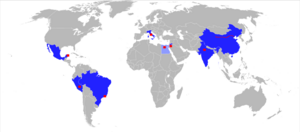New 7 Wonders of the World facts for kids

The New 7 Wonders of the World was a fun project that started in 2001. Its goal was to pick seven amazing new "Wonders of the World" from a list of 200 famous places. People voted for their favorites online for free, and some also voted by phone.
A man named Bernard Weber from Switzerland led this big vote. The New 7 Wonders Foundation, based in Switzerland, organized everything. The winners were announced on July 7, 2007, in Lisbon, Portugal. Many people voted, making it one of the biggest polls ever!
Some countries were very excited and encouraged their people to vote for their national landmarks. However, the United Nations' cultural organization, UNESCO, said they were not part of this contest. They explained that their own list of World Heritage Sites is based on scientific and educational reasons, not just a popularity vote.
The seven winners were chosen from 21 places that were picked by a special group in 2006. The New 7 Wonders Foundation used private donations and money from selling TV rights to run the project.
The foundation also ran two other similar projects later: the New 7 Wonders of Nature (for natural places) and New7Wonders Cities (for cities).
Contents
The Winners
The Great Pyramid of Giza in Egypt was given a special "honorary status." This is because it's the only one left from the original Seven Wonders of the Ancient World.
| Wonder | Location | Image | Year |
|---|---|---|---|
| Giza Pyramids (honorary status) |
Giza Necropolis, Egypt | 2560 BC | |
| Great Wall of China | China |  |
700 BC |
| Petra | Ma'an, Jordan |  |
312 BC |
| Colosseum | Rome, Italy | AD 80 | |
| Chichén Itzá | Yucatán, Mexico |  |
AD 600 |
| Machu Picchu | Cuzco Region, Peru |  |
AD 1450 |
| Taj Mahal | Agra, India |  |
AD 1643 |
| Christ the Redeemer | Rio de Janeiro, Brazil |  |
AD 1931 |
How Countries Reacted
United Nations' View
In 2007, the New 7 Wonders Foundation tried to work with the United Nations. However, UNESCO, which is the UN's group for education and culture, said they had nothing to do with the contest.
There is no comparison between Mr. Weber's campaign and the scientific and educational work resulting from the inscription of sites on UNESCO's World Heritage List. The list of the 8 New Wonders of the World will be the result of a private undertaking, reflecting only the opinions of those with access to the Internet and not the entire world. This initiative cannot, in any significant and sustainable manner, contribute to the preservation of sites elected by this public.
—UNESCO
UNESCO explained that their own list of World Heritage Sites is very different. Their list is based on careful study and helps protect important places. The New 7 Wonders list, they said, was just a private vote by people online.
Brazil's Campaign
In Brazil, there was a huge campaign called Vote no Cristo (Vote for the Christ). Companies, especially phone companies, helped by letting people vote for free. Big sponsors spent a lot of money to get the Christ the Redeemer statue voted into the top seven.
People in Rio de Janeiro even got text messages asking them to vote. TV ads showed famous people next to the statue. It was a very big effort!
Peru's Excitement
Peru's government also ran a big campaign to get people to vote for Machu Picchu. The news and media talked about it a lot. When Machu Picchu was announced as a winner, people all over Peru celebrated!
Chile's Moai Statues
The person representing the Moai statues from Easter Island in Chile said they finished eighth. He mentioned that the organizer, Bernard Weber, sent him a letter saying the Moais were "morally" one of the New 7 Wonders.
India's Support
In India, there was a big push to get votes for the Taj Mahal. News channels, radio stations, and many famous people asked everyone to vote for it.
Jordan's Queen
Queen Rania herself joined the campaign to support Petra, which is a national treasure in Jordan.
Mexico's Vote
News programs in Mexico also encouraged people to vote for Chichén Itzá.
Other Finalists
Here are the other 13 amazing places that were finalists in the contest:
| Wonder | Location | Image | Year |
|---|---|---|---|
| Stonehenge | Amesbury, United Kingdom |  |
2400 BC |
| Acropolis of Athens | Athens, Greece |  |
447 BC |
| Hagia Sophia | İstanbul, Turkey |  |
537 |
| Angkor Wat | Angkor, Cambodia |  |
1113 |
| Moai Statues | Easter Island, Chile |  |
1250 |
| Timbuktu | Timbuktu, Mali |  |
1327 |
| Alhambra | Granada, Spain |  |
1333 |
| Kremlin and Red Square | Moscow, Russia |  |
1561 |
| Kiyomizu-dera | Kyoto, Japan |  |
1633 |
| Neuschwanstein | Füssen, Germany |  |
1869 |
| Statue of Liberty | New York City, United States |  |
1886 |
| Eiffel Tower | Paris, France |  |
1887 |
| Sydney Opera House | Sydney, Australia |  |
1973 |
See also
 In Spanish: Nuevas siete maravillas del mundo moderno para niños
In Spanish: Nuevas siete maravillas del mundo moderno para niños
- Wonders of the World
- Seven Wonders of the Ancient World
- Eighth Wonder of the World
- World Heritage List – a list of over 900 sites that UNESCO thinks are very important to the world.


